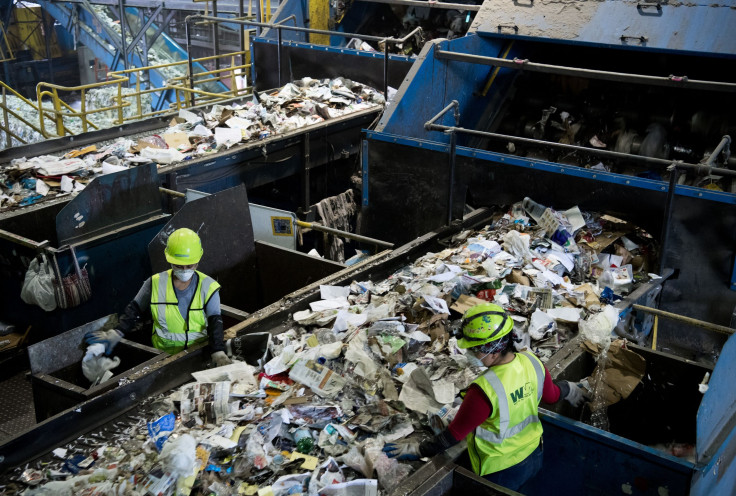US Recycling Industry, Worth $100 Billion, Needs Creative Solutions Amid Ongoing Downturn

Recycling is a $100 billion industry that employs half a million people in the United States, but scores of headlines this year have suggested it’s in a downward spiral. This alleged demise is due to high contamination, disrupted international trade, and unstable commodity prices. But the reality is that recycling is not plummeting to its death. Chaz Miller, a veteran of the industry, reminds us that this is the sixth significant downturn since 1990. Recycling has weathered and forged new opportunities from market chaos in the past. Miller also notes that some scrap dealers anticipate declines every few years and they plan for it, which is something other recycling stakeholders can strive to do: plan for the long-term whether markets are hot or, like at present, cold.
For years, the U.S. has exported a third of its recyclables, half of which have gone to China. Empty cargo containers sailing from the U.S. back to China were made useful with recycled materials for export. Chinese manufacturers and American companies alike became dependent on the exchange. Simultaneously, the rise of single-stream recycling in U.S. communities has ushered in higher contamination, resulting in lower quality materials. Now, China aims to strengthen its domestic recycling infrastructure and no longer wants these low quality goods. This year, China banned 24 types of scrap materials and released a strict 0.5 percent contamination limit, leaving many U.S. companies in search of new buyers.
This upheaval is a chance to stabilize our recycling system to let it thrive. We need each stakeholder group, from producers and consumers to government, to take part in improving the quality of recyclables and shifting demand to close the loop. Consumers have many ways to express demand, like the products we choose to purchase. But in order for consumers to make an informed choice in the store, we need clear communication. Brands can help by labeling their products’ recycled content and making sure that customers know tackling waste is a company-wide priority.
Consumers also express demand through social media by tagging companies in public requests for increased sustainability and transparency on practices. Most consumers believe transparency is a more important quality of businesses than ever before, and 85 percent will stick by a company through crisis if it’s known for transparency. Additionally, results from a recent Recycling Partnership survey show that 74 percent of Americans would rather buy from a business that makes every effort to recycle and reuse materials. People are signaling a demand through surveys and social media, but it’s up to producers to present the opportunity to see if this demand will translate into purchasing choices.
Reducing waste and supporting the recycling system should not be the only practices of a company claiming to be concerned with sustainability. But fundamental to being a “green” company is exploring how to use resources more efficiently, along with using clean energy, reducing its production emissions, and ensuring employees have a safe workplace and fair wage throughout its supply chain. Aside from clear labeling to help individuals, companies can steer demand by committing to using recycled content in products. For example, Nike employs a variety of recycled fiber in three-quarters of its footwear and apparel, including recycled cotton, polyester, and leather. It also uses its own production scraps as inputs for new footwear. LUSH Cosmetics is committed to using 100 percent recycled content packaging, and offers its products in-store free of all packaging to reduce waste. LEGO is striving to increase recycled content and ensure its packaging is recyclable in all major markets. Its addition of How2Recycle labels on the packaging offers clear steps for consumers to recycle. Companies can also use stores as collection channels for recyclables. Best Buy has collected over one billion pounds of electronic waste in its recycling program, and also prioritizes “reuse” before recycling, by offering repair services (totaling 5 million devices in FY18) and a trade-in program for gently used items to be resold at a discounted rate.
Beyond using recycled content, producers need to design products for recyclability. Stronger communication between producers and recyclers can aid in this process. Greater collaboration is needed between the recycling systems’ varied stakeholders to guarantee its long-term stability. Participants in one part making decisions without considering the effects in other areas is a recipe for continued dysfunction and disappointment.
Instead, let’s look to higher standards, clearer goals, and greater transparency on how progress is being achieved. We can map out how to navigate this turmoil in more nuanced ways than just apocalyptic projections that incite confusion. History reminds us not to panic in the face of this downturn but to instead exercise creative, widespread solutions that can lead recycling to yield to even greater environmental and economic benefits.
Beth Porter is the author of "Reduce, Reuse, Reimagine", and is climate & recycling director at Green America.
© Copyright IBTimes 2024. All rights reserved.





















